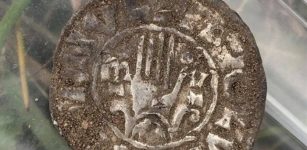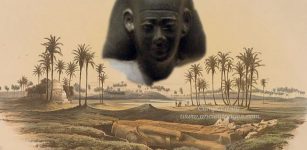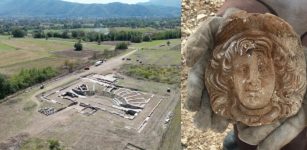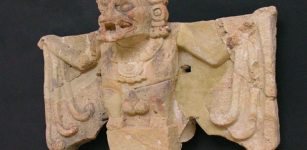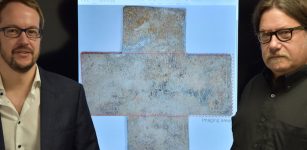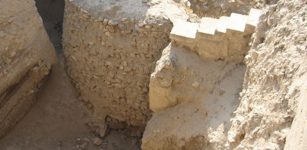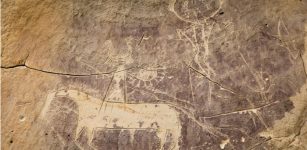Unique 1,800-Year-Old Stone Sarcophagus Exposed In Ashkelon Building Site
One of the most important and beautiful sarcophagus has been improperly removed from the ground, the Israel Antiquities Authority said.
A unique and extremely impressive stone sarcophagus, about 1,800 years old, was exposed at a building site in the new neighborhood of villas currently going up in Ashkelon.

A member of the Israel Antiquities Authority (IAA) cleans the head of the monstrous mythological female figure Medusa which includes images of the venemous snakes that she was said to have as hair on a unique Roman-era sarcophagus adorned with the carving of a young man at a warehouse in Bet Shemesh on September 3, 2015. (AFP PHOTO/MENAHEM KAHANA)
One of the rarest sarcophagi, ever discovered in Israel, was severely damaged when building contractors, who found it, decided to extract it themselves with a tractor, damaging it before hiding it beneath a stack of metal sheets and boards, according to the Israel Antiquities Authority.

Male figure sculpted on the sarcophagus cover
Copyright: Yoli Shwartz, courtesy Israel Antiquities Authority
The coffin, which is made of hard limestone, weighing about 2 tons and 2.5 meters long, is sculpted on all sides. A life-size figure of a person is carved on the sarcophagus' lid. The sarcophagus was repeatedly struck by a tractor in different places, scarring the stone and damaging the decorations sculpted by an artist on its sides.
Dr. Gabi Mazor, a retired IAA archaeologist and an expert on classical periods, described the scene on the sarcophagus:

An Israel Antiquities Authority (IAA) worker cleans naked cupids on a unique Roman-era sarcophagus at a warehouse in Bet Shemesh on September 3, 2015. (AFP PHOTO/MENAHEM KAHANA)
"One side of the sarcophagus lid is adorned with the carved image of a man leaning on his left arm. He is wearing a short-sleeved shirt decorated with embroidery on the front. A tunic is wrapped around his waist. The figure's eyes were apparently inlaid with precious stones that have disappeared and the hair is arranged in curls, in a typical Roman hairstyle. On the other side of the lid is a carved relief of a metal amphora (a vessel used for transporting liquids such as wine) from which there are intertwining tendrils bearing grape clusters and grape leaves.

The sarcophagus and lid during the initial cleaning
Copyright: Yoli Shwartz, courtesy Israel Antiquities Authority
The sarcophagus itself, which was more severely damaged by the tractor, is decorated with, among other things, wreaths and images of bulls' heads, naked Cupids, and the head of the monstrous female figure Medusa which includes remains of hair together with snakes, part of a commonly held belief in the Roman period that she protects the deceased."
According to Mazor, "Such sarcophagi were usually placed in or next to a family mausoleum. The high level of decoration attested to the family's affluence, which judging by the depicted motifs was probably not Jewish."
Police found and detained construction workers who damaged relic and concealed finding. Legal proceedings will now be taken against those involved.
AncientPages.com


